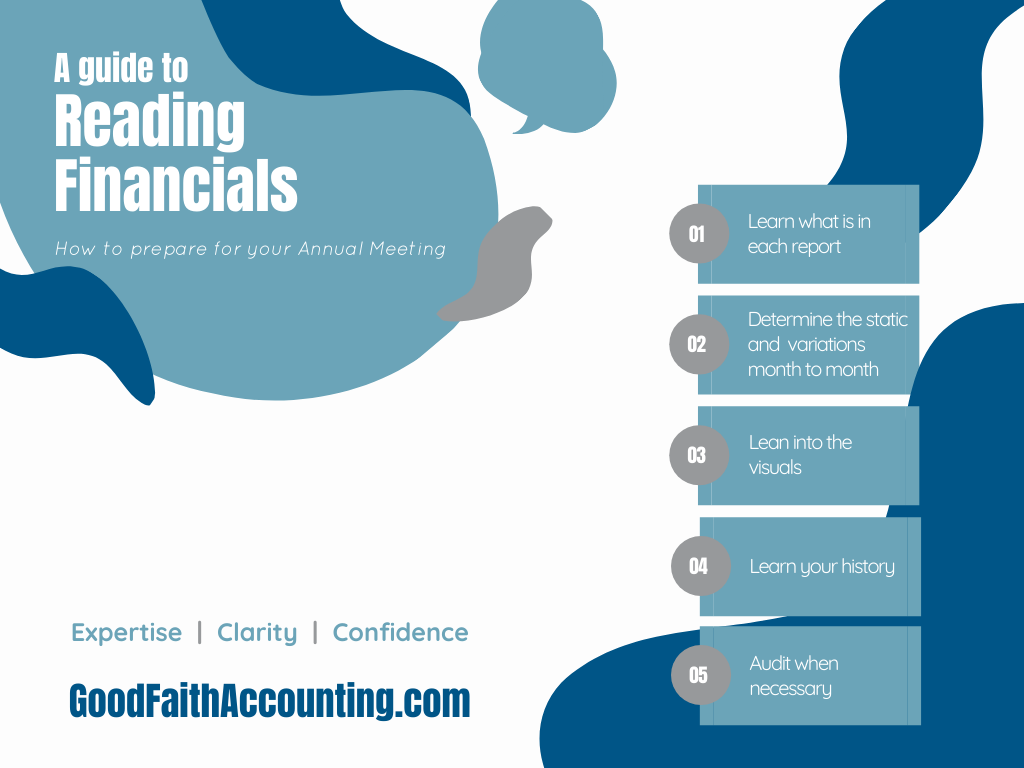September 14, 2021
Preparing Financial Reports for your Annual Meeting
When you are reporting to the board and membership during the annual meeting, it is key to report ALL financial data. We know that can be tricky, but we’re here to help. We are about to break down the financials like you’ve never seen them before.
First, we want to go over reading the financials in brief, what specific pieces to pay attention to, and then what to discuss in your annual meeting. Read to the end to find your Guide to Reports.
Reading Financials in General
When we say to report all financial data, we suggest a Statement of Financial Position (often referred to as the Balance sheet) and a Statement of Activities (otherwise known as the Income Statement). The Statement of Financial Position records what you own as of the date on the report and the Statement of Activities tracks what is happening year to date, by account.
Unpacking the Reports Produced Monthly
Financial statements should be produced monthly and a compilation report produced at the end of each fiscal year. This gives the organization a better picture of expenses versus giving each month, which helps leadership make more informed decisions.
- The Statement of Financial Position should include:
- All Bank Accounts – ALL accounts opened with the church’s federal ID#
- Building and Land owned by the church (ALL, not just the church)
- Liabilities – short- and long-term loans
- Restrictions on Cash
- Unrestricted Equity
- Net Balance from the Statement of Activities (Income Statement)
- The Statement of Activities will include ALL income and expenses.
Inside the Statement of Activities is housed the Chart of Accounts. The purpose of having a chart of accounts is to capture what happened in total for each of those accounts so that leadership has a true picture of what happened and can make appropriate decisions based on the activity.
The Static
Once the proper accounts are setup and on the financials – we’ll refer to that as the “general section” – there’s not much that needs to be heavily evaluated month-to-month. Your Building and Land, for instance, shouldn’t change; unless there is a major change such as a sale of a building. Also, your Liabilities are generally payroll related, so once you have a consistent payroll system in place, that shouldn’t vary much either.
These are the easier items to decipher, and in turn report on, during a meeting with the financial team. Next, we’ll unpack the non-static part of the reports.

The Variations
This is where is gets good! 
Financial Position (where we stand):
- Cash: Highlight the cash in the bank, and then look at the Cash Available for General Operations box, to see how much can be used for anything (not restricted or needing to be used soon). It can also be helpful to mention what the trend has been over the past few months (is the balance increasing or decreasing?)
- Any unusual liabilities or other changes (for example, noted the PPP loan when it was received and listed as a liability). Otherwise, these items are generally consistent.
- Restricted funds: note any balances or funds received/spent that are unusual or large (for example, the final total we received for the Christmas offering, or the YTD building fund balance)
Activity (what we received vs. what we spent):
- Expenses compared to budget
- Revenue compared to expenses (net balance from operations)
- YTD current year revenue & expenses compared to prior YTD revenue & expenses (the graph in our standard financial format)
Learn more in our Starting Accounting for Church Plants post
The Visuals
The charts Miller Management provides are easier for board members & congregations to understand, instead of the pages of financials. In addition to the financial statements, we provide a weekly dashboard email – with charts and graphs – to highlight how the organization is doing. Read more about our awesome dashboard product here.
“If you do use the financials, I’ve found it helpful to highlight the key numbers to help the readers reference the information.”
Laura Sappington, MM Accountant & Finance Committee Member at local church
Reports for the Annual Meeting
Now that you know more about reading those lovely financials you receive each monthly, and how to best report on them at your monthly finance meetings, it’s time to tackle the Annual Meeting.
The good news is that the Compilation Report is mostly the same as each monthly report. Except, the final report for the full fiscal year shows what the ministry owns and owes as of the last day of the fiscal year. Plus, the total revenues received and expenses incurred throughout the full twelve-month period. Think of it as a comprehensive exam in your history class. Yes, you have to know all the important moments that took place in history, but aren’t they really just building upon each other? And doesn’t history as a whole make more sense when you look at it that way?
Okay, back to the matter at hand. Outside of the financial position of the ministry shown on the reports, there are other logistical and legal items that should be reviewed. The link below contains a good overview of things to consider annually.
Financial reports and audits:
Richard Hammar has a list of 15 Way to Prepare for the Annual Business Meeting. Today we want to highlight #11 on his list: Financial Reports and Audits.
“Be sure to review the church’s bylaws to see what kinds of reports must be presented at the annual business meeting. To illustrate, some church bylaws require an annual audit, and a presentation of the audit at the annual business meeting. Be sure the church complies fully with such a requirement. Note that the word ‘audit’ has a specific meaning. It does not include various ‘limited engagements’ that CPAs can perform. If your bylaws call for an audit, be sure that the financial report that you present in your annual membership meeting is in compliance with your church bylaws.”
Guide to Reading Financials
We hope this has been a helpful way to prepare you for your upcoming Annual Meeting at your organization. For Miller Management clients, this sort of training is available for all of our partnerships. Our experts of Accountants are happy to take the time for you to fully grasp what is going on in your church. That is our truest goal: to help leadership make informed and confident decisions regarding their finances.
We will leave you with this five step guide to reading your reports and hope you will reach out to your representative if things are still unclear in your specific case.

Stay Connected